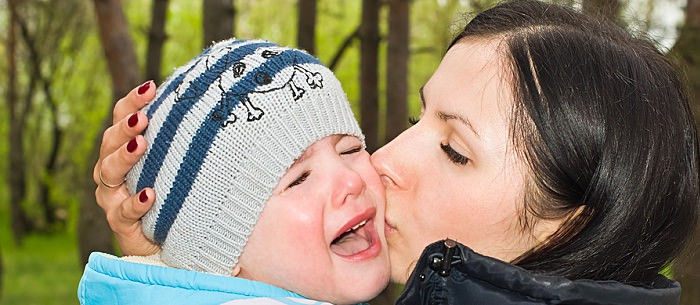No matter how vigilant you are, your baby will take her first tumble at some point. But that’s okay. It’s all a part of her growing up and finding her feet, literally! Most baby falls are harmless, but that doesn’t make the initial shock (for both of you) and the tears any easier to deal with.
According to Dr. Stacy Suskauer, director of brain injury rehabilitation programs at Kennedy Krieger Institute, the most important thing to do as you react and assess your little one for damage is to remain calm and use your common sense. “Not every bump on the head requires a visit to the doctor, but in some cases, it’s better to be safe than sorry,” she says.
Here’s what to expect, what you should know and what to do when your baby has a fall:
- Offer Immediate Comfort and Attention
This isn’t the first time your baby has done something to worry you, so it triggers your calm and caring side. When you approach your baby after her first fall, remember that she’ll feed off your anxiety, but also be reassured by your patience and composure. According to Dr. Carol Wilkinson, a developmental pediatric fellow at Boston Children’s Hospital and medical director of Kinsights, your child needs comfort and often a distraction to make her feel better, and to allow you time to assess any problems. “I like counting to 10 or singing a favorite song to distract a child from the shock of the fall,” she says. You need to stay focused on your child, so delegate jobs — such as getting the first-aid kit — to others around you.
- Recognize and React to Serious Injuries
Cuts:
Scrapes and cuts will be clearly apparent, and you’ll be able to tell how serious they are quickly. According to the American Academy of Pediatrics (AAP), you should apply continuous pressure to the wound to slow down bleeding. When it stops, wash the wound with plain water and apply an antibiotic ointment. Then cover it with a sterile dressing. If bleeding continues after five minutes of pressure, call your doctor. You should also call the doctor if the cut is deeper than the skin layers, or if it’s longer than half an inch.Broken bones: According to the AAP, fractures (another name for breaks) are the fourth most common injury among children under age six. It isn’t always easy to tell when your child has broken a bone. Typically, your child won’t be able to move the injured limb and it will swell, and your child will be in obvious discomfort or pain. However, just because your child can move the limb doesn’t mean it’s not broken. Always call your pediatrician to be sure. Until you can get to the emergency room, splint the injury with a makeshift sling or newspaper to restrict your child’s movement. You can see what a finished splint looks like on the John Hopkins Medicine’s All Children’s Hospital site. Don’t give your child any pain medication or liquids without speaking to your doctor first. If your child has broken a leg, don’t try to get him to the hospital yourself. Call 911 and let the paramedics transport him safely.
Head injuries: Most bumps on the head are harmless. For anything other than a light bump, the AAP recommends calling your pediatrician to advise her of the situation. If there is swelling from a light bump, you can apply a cold compress for 20 minutes to help the swelling go down. You can tell if the bump is more serious if your child cries for more than about 10 minutes, is less alert than normal and doesn’t respond to you. According to Dr. Wilkinson, other signs to look out for include vomiting, increased sleepiness and changes in your child’s movement, speech or vision. “In addition, if your child continues to complain of a headache or neck pain, or if she is difficult to console, take her to the doctor,” Dr. Wilkinson says. Be sure to watch your little one carefully for 24 hours after her first fall to spot any changes in her behavior. Additionally, if your child loses consciousness for any amount of time, take her to the doctor immediately.
- Keep an Eye Out for Subtle Signs of Further Damage
If you don’t see any cuts or scrapes, swelling, broken bones or signs of other internal injuries, and your child seems OK after some comfort, continue to keep an eye on her. Dr. Suskauer says that tiredness outside of your child’s regular sleep schedule could indicate a more serious injury. If you observe her for a few hours after the fall and she’s acting her usual self, it’s fine to put her down for her regular nap. If she sleeps past her normal wake-up time, go in and check on her to make sure she stirs easily. Dr. Wilkinson warns parents against using pain medicine like ibuprofen without advice from your pediatrician. “You don’t want to mask pain that could be a sign of something more serious,” she says.
Baby falls are inevitable, but it doesn’t stop you worrying the first time it happens. You can help prevent serious injuries from spills and tumbles around the house by baby proofing your home. The AAP suggests using gates on stairways and doors, window guards on high windows and removing sharp-edged and hard furniture from rooms used by the baby for play. And never use a baby walker — these give kids access to objects and areas they wouldn’t normally get to and you probably haven’t baby proofed.
And read our guide to developmental milestones for kids.
Rebecca Desfosse is a freelance writer specializing in parenting and family topics.
* This article is for general informational purposes only. It is not intended nor implied to be providing medical advice and is not a substitute for such advice. The reader should always consult a health care provider concerning any medical condition or treatment plan. Neither Care.com nor the author assumes any responsibility or liability with respect to use of any information contained herein.






